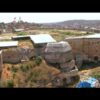Hearst Castle Video
Hearst Castle Video
Anything but Humble: Hearst Castle Video - 750 Hearst Castle Road San Simeon United States/ Visitors have a rare opportunity to see the white marble floor of the empty Neptune Pool while it undergoes restoration. The pool was initially drained because of leaks, but the action was also part of a larger water conservation effort at Hearst Castle during the current severe drought. \Hearst Castle’s history begins in 1865, when George Hearst purchased 40,000 acres of ranchland. In 1919, William Randolph Hearst inherited what had grown to more than 250,000 acres, and was dreaming of ways to transform it into a retreat he called La Cuesta Encantada—Spanish for “Enchanted Hill.” By 1947, Hearst and architect Julia Morgan had created Hearst Castle: 165 rooms and 127 acres of gardens, terraces, pools and walkways—all built to house Hearst’s specifications and to showcase his legendary art collection.In 1865, George Hearst purchased 40,000 acres of ranchland that included the mexican ranchos of Piedra Blanca, San Simeon and Santa Rosa. In 1919, his son, William Randolph Hearst, inherited the land from his mother, Phoebe Apperson Hearst. He eventually expanded it to encompass 250,000 acres.Originally known as “Camp Hill,” its wilderness offered a magnificent campsite for family and friends, but Hearst envisioned more comfortable accommodations. His simple instructions to famed San Francisco architect Julia Morgan in 1919 were: “Miss Morgan, we are tired of camping out in the open at the ranch in San Simeon and I would like to build a little something.”Hearst renamed the hilltop that crowned his huge ranch “La Cuesta Encantada” – The Enchanted Hill. By 1947, Hearst and Morgan had created an estate of 165 rooms and 127 acres of gardens, terraces, pools and walkways – an American castle that was destined to become one of the world’s greatest showplaces for his art collection. hearstcastle.org Fly over the mansion William Randolph Hearst built and George Bernard Shaw deemed, "The place God would've built if he had the money." Smithsonian Channel

